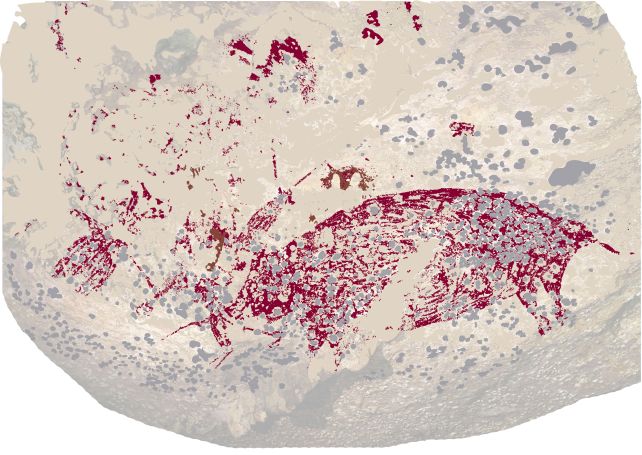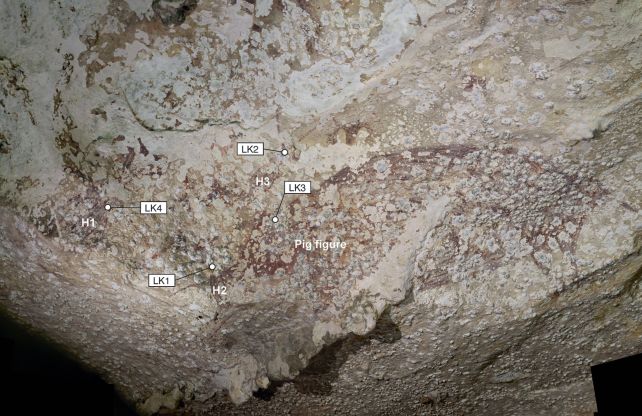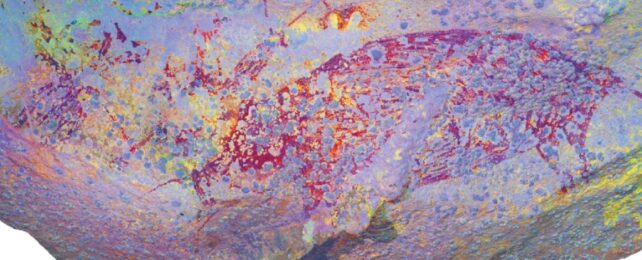Many millennia ago, in what is now the island of Sulawesi, Indonesia, humans ground up some pigment and daubed pigs and people on the walls of a cave.
Using cutting edge techniques, scientists have now determined that these ancient depictions could include the oldest known figurative, and narrative, examples of art in the world. They date back to at least 51,200 years ago – older than previous record-holders by thousands of years.
"This narrative composition, which depicts human-like figures interacting with a pig, is now the earliest known surviving example of representational art, and visual storytelling, in the world," writes a team of archaeologists led by Adhi Agus Oktaviana and Maxime Aubert of Griffith University in Australia.
"Our findings show that figurative portrayals of anthropomorphic figures and animals have a deeper origin in the history of modern human (Homo sapiens) image-making than recognized to date, as does their representation in composed scenes."

Archaeologists have known about Sulawesi's wealth of ancient cave art for some time. In 2019, a team that included Aubert discovered that a scene in a cave called Leang Bulu' Sipong 4 in which human-like figures cavort with animals is up to 43,900 years old. At the time, it was the oldest known cave art identified to date that featured some kind of narrative.
Two years later, another cave painting in Sulawesi – discovered by a team that also included Aubert – took the record for oldest painting representing a real object, with a depiction of a pig that was dated to at least 45,500 years ago.
The new research has used a new dating method, and found that not only is the Leang Bulu' Sipong 4 art older than we thought, closer to around 48,000 years old, but that previously undated art in a different nearby cave called Leang Karampuang is even older.
The new technique is called laser-ablation uranium-series imaging, and it relies on a quirk of limestone deposition in caves. As water seeps through the limestone rock of the cave, it collects a small amount of uranium. Then, when that water flows over a cave painting, it deposits a film of calcite that gradually accumulates over the millennia – not enough to conceal the painting, but enough to leave a thin coating.
Over time, uranium decays into thorium at a precisely known rate. Since thorium isn't water-soluble, any measurements of the element in the calcite coating must represent traces of uranium that decayed after the surface water evaporated or flowed away.
Using laser ablation, the researchers removed and measured the uranium and thorium in samples. Knowing the rate of radioactive decay, they used these amounts to calculate the amount of time that had passed since the calcite was deposited over the paintings.
This dating method allowed the researchers to recalculate the age of the Leang Bulu' Sipong 4 scene.

Then, they applied it to the painting in Leang Karampuang, which features in very faint and somewhat degraded red pigment three human-like figures interacting with pig. This has given us a cave painting that, as far as we currently know, is the world's oldest representation of figures, both human-like and animal; and depicts some sort of story, even if the details are now lost to the eons.
But it's not just the one painting. There are a lot of very similar, and very old, cave paintings on Sulawesi, and also the nearby island of Borneo, suggesting the region is one of great importance to the cultural history of Homo sapiens.
"On the basis of our dating work, it now seems that depictions of anthropomorphic figures (including therianthropes) interacting with animals appear in the Late Pleistocene cave art of Sulawesi at a frequency not seen elsewhere until tens of millennia later in Europe," the researchers write.
"This implies that a rich culture of storytelling developed at an early period in the long history of H. sapiens in this region – in particular, the use of scenic representation to tell visual stories about human-animal relationships."
That faintly discernible pig may be the most important pig in human history.
The research has been published in Nature.
